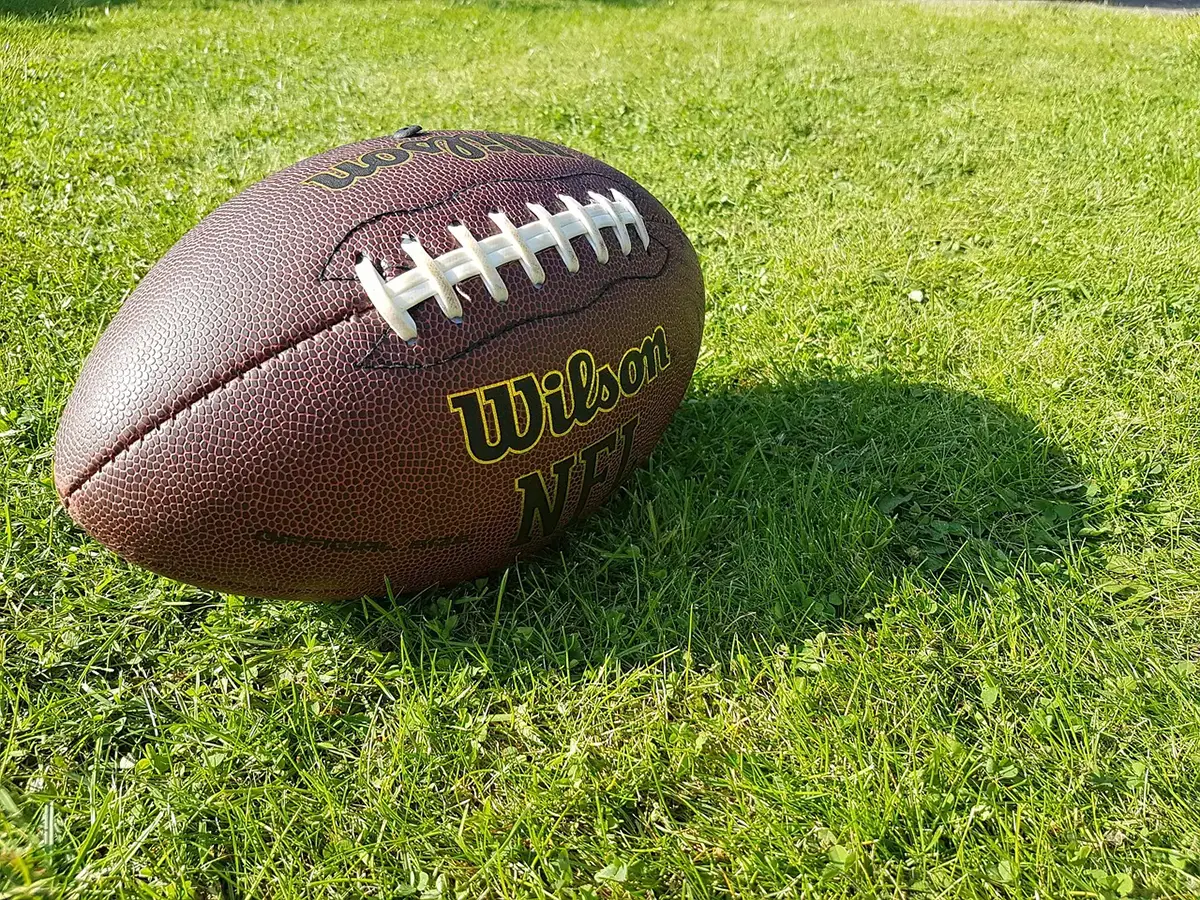If you’re someone looking for a sport with a healthy dose of competition but without full-body contact, an adult flag football league could be just the ticket. Don’t know how or where to play? By the end of this blog post, you’ll understand the game and be ready to join an adult flag football league near you.
A Basic History of Flag Football
The Origins of Flag Football

Flag football is thought to have originated around the time of World War II. American servicemen wanted to play football during their downtime but couldn’t risk getting hurt from tackles or other contact.
The servicemen devised a plan–use flags to pull off opponents’ waists to signify tackles. And thus, flag football was born.
Today’s Flag Football
Today, both adults and children play flag football.
The sport is especially popular with adults because of its limited physical contact. There are adult flag football leagues nationwide, and many social sports leagues and parks and recreation districts also offer the sport.
You’ll find leagues that range from beginner to ultra-competitive. If you’re looking for a men’s league, women’s league, co-ed league, or an LGBTQ+ league, there’s an adult flag football league just for you.
The Rules of Flag Football Even a Beginner Can Understand
Understanding the Basics of Flag Football
Flag football is similar to traditional American football in many ways. The most notable difference is one we’ve already mentioned–the way players are “tackled.” Instead of physical tackles, players wear flags that hang along their waists. The defensive team must remove a flag from the ball carrier to end a play.
Regardless of the type of football, the intent is to score as many points (touchdowns, field goals, or extra points) as possible.
The Field and Teams
A standard flag football field is similar to a regular football field (which is 100 yards) but can be smaller in size, depending on the league. Teams typically have 5 to 8 players, but this number can also vary. The objective is to score touchdowns by advancing the ball to the opponent’s end zone.
Key Rules to Remember
Get Down With Downs
Like regular football, flag football teams have four chances (downs) to advance the ball ten yards. If they don’t succeed, the opposite team gets the ball.
If they make it ten yards, the downs reset, and the team attempts to make it at least another ten yards, with the ultimate goal of running or passing the ball into the end zone for a touchdown.
The end zone is exactly what it sounds like–it’s the end of the football field.
Starting the Play: The game begins with a kickoff and teams alternate ball possession.
Moving the Ball: Players can advance the ball by running with it or passing it to teammates. The ball carrier cannot guard their flags.
Scoring: A touchdown is worth six points. After scoring a touchdown, teams attempt to score an extra point by kicking the ball between the goalpost. Teams can also attempt field goals. A team may opt for a field goal if they don’t think they can make the touchdown. The kicker aims to kick the football through the goalposts from the distance of the last play. Field goals are worth three points.
Turnovers: Interceptions (catching an opponent’s pass) and fumbles (ball dropped by a team and picked up by an opponent) can change possession of the ball.
No Contact: Physical contact is minimal. Blocking and tackling are not allowed, making the game safer and more focused on skill and strategy.
You can see the game in action here, with explanations for beginners.
Flag Football Positions And Which Might Be Right For You
In flag football, each player has a specific role to play. Understanding these positions is a good entry point for anyone new to the game. Try out a few positions to see which might be the best fit for you.
Offensive Positions
Quarterback (QB)
Role: The quarterback is the leader of the offense. The QB calls the plays and passes or hands off the football at the start of each play.
Skills You’ll Need: Good decision-making, accurate throwing, and a solid understanding of the game.
Running Back (RB)
Role: Positioned near the quarterback, the running back’s primary role is to run with the ball after receiving a handoff or to catch passes.
Skills You’ll Need: Speed, agility, and the ability to read defenses.
Wide Receiver (WR)
Role: Wide receivers line up near the sidelines and run routes to catch passes from the quarterback.
Skills You’ll Need: Speed, good hands for catching, and the ability to run precise routes.
Center
Role: The center snaps the ball to the quarterback and can then act as a blocker or receiver.
Skills You’ll Need: Accurate snapping ability and versatility.
Defensive Positions
Defensive Back (DB)
Role: Defensive backs cover receivers to prevent them from catching passes and aim to pull flags.
Skills You’ll Need: Speed, good reaction time, and the ability to read the opponent’s offense.
Linebacker (LB)
Role: Linebackers play behind the defensive line and are versatile players who defend against both the pass and the run.
Skills You’ll Need: Agility, good tackling (flag pulling) skills, and quick decision-making.
Rusher
Role: The rusher, also known as the blitzer, tries to rush the quarterback and pull their flag before they can pass the ball.
Skills You’ll Need: Speed and the ability to anticipate the quarterback’s moves.
Special Teams
Some leagues have special teams for kickoffs and punts, but these roles can vary based on the specific league rules.
Flexibility and Strategy
In adult flag football, players often play multiple positions or switch positions based on the team’s strategy. The key is understanding the basics of each role and being adaptable.
Essential Skills for Flag Football
If you want to become a proficient adult flag football player, you should focus on improving your agility, accurate catching and passing, and nailing the tackle–or the flag pull.
Agility takes the lead in these skills. Swift footwork and the ability to instantly shift direction are vital. Being agile will enable you to dodge your rivals and perform crucial flag pulls.
Throwing and catching abilities also play a significant role. A well-executed throw can swing the game in your favor, and an accurately timed catch can score you coveted points. Regular practice of these skills will help sharpen your coordination and timing.
Hand-eye coordination is yet another skill to focus on. If your hand-eye coordination–and timing–are on point, you’ll be in the best position to pull flags off your opponent and prevent them from moving the ball forward or scoring.
Ways to Prepare to Play Flag Football as an Adult
There are many ways you can train to play flag football proficiently. Below are a few solo exercises and training ideas to help you gain confidence before you step onto the gridiron for the first time.
Increase Cardiovascular Fitness
Activity: Interval Running
How to Do It: Alternate between sprinting and jogging. Start with 30 seconds of sprinting followed by 1 minute of jogging. Repeat this cycle for 15-20 minutes.
Benefits: Improves endurance and speed, which are crucial for flag football.
Improve Agility
Activity: Ladder Drills
Equipment You’ll Need: Agility ladder (or you can create one with tape or chalk)
How to Do It: Perform various footwork exercises through the ladder, such as the Ickey Shuffle, in-and-out hops, and lateral shuffles. Watch the video to see it done.
Benefits: Enhances foot speed, coordination, and agility.
Gain Strength
Activity: Bodyweight Exercises
Exercises: Include push-ups, squats, lunges, and planks in your routine.
How to Do It: Aim for three sets of 10-15 reps for each exercise.
Benefits: Builds core strength and overall muscle endurance.
Become an Expert Flag Puller
Activity: Solo Flag Pull Drill
How to Do It: Hang a flag or a piece of cloth at waist height and practice approaching and grabbing it quickly and accurately.
Benefits: Improves your ability to pull flags in a game situation.
Nail Your Passing and Catching
Activity: Wall Ball
Equipment You’ll Need: Football
How to Do It: Throw the ball against a wall and practice catching it on the rebound. Vary the throwing angle and force.
Benefits: Enhances hand-eye coordination and passing accuracy.
Finding Local Adult Flag Football Leagues
Now that you understand flag football rules and have done some training to prepare for your first game, it’s time to find a league near you.
Wrap Up
Whether you’re a newbie adult athlete or simply trying out a new sport in flag football, getting and staying active in your 20s, 30s, 40s, 50s, and beyond is a great way to extend your longevity in life. Besides the physical benefits of playing sports as an adult, the mental health benefits and friendships you’ll form are worth their weight in gold.







